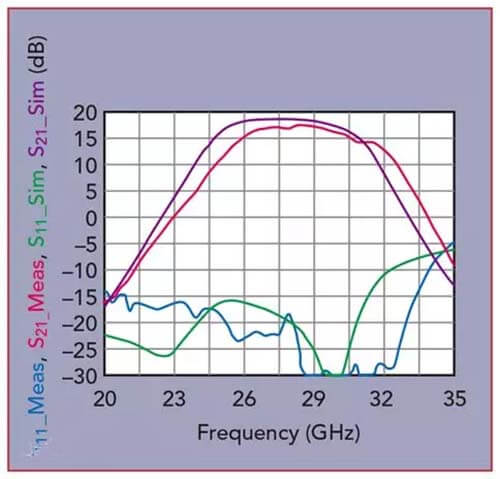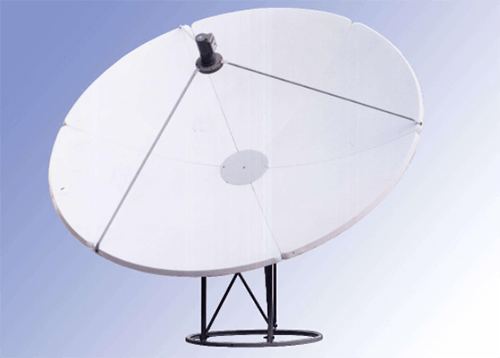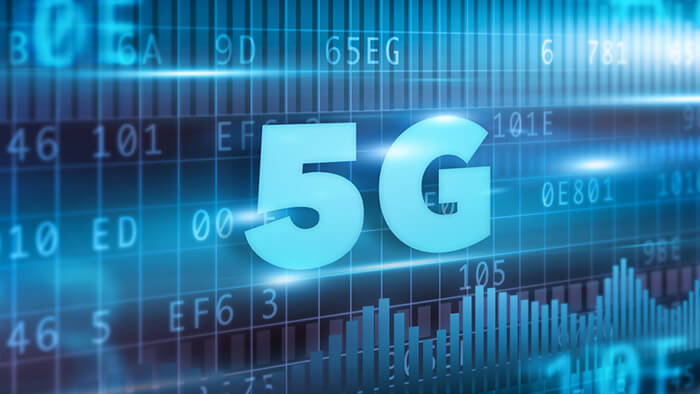What is the 5G C-band frequency?

C-band is a band of frequencies from 4.0-8.0 GHz, used as a frequency band for downlink transmission of signals from communication satellites. This band was first adopted and has been widely used in satellite TV broadcasting and small satellite earth station applications.
According to the IEEE 521-2002 standard, 5G C-band refers to the radio wave band with frequencies between 4 and 8 GHz. The typical uplink frequency range is 5.925-6.425 GHz, and the downlink frequency is 3.7-4.2 GHz, i.e., 500 MHz each for the uplink and downlink bandwidths.
5G C-band requires a large positive-feed antenna. Usually, a split pot consisting of six flaps or an integral pot can be used.
In the early days, satellite communication used C-band, but later, because C-band became crowded, Ku-band, Ka-band, etc., appeared one after another.
Generally speaking, the lower the frequency band used by microwave remote sensing satellites, the stronger the penetration; the higher the frequency band, the weaker the penetration, but the lower frequency band is not easy to achieve high resolution. Scientists have found that the 5G C-band is more advantageous in applying satellites to distinguish targets.
Other microwave bands (band name, frequency range, wavelength range).
Band Name | Frequency Range | Wavelength Range |
L-band | 1 – 2 GHz | 300.00 – 150.00 mm |
S-band | 2 – 4 GHz | 150.00 – 75.00 mm |
C-band | 4 – 8 GHz | 75.00 – 37.50 mm |
X-band | 8 – 12 GHz | 37.50 – 25.00 mm |
Ku-band | 12 – 18 GHz | 25.00 – 16.67 mm |
K-band | 18 – 27 GHz | 16.67 – 11.11 mm |
Ka-band | 27 – 40 GHz | 11.11 – 7.50 mm |
Q-band | 30 – 50 GHz | 10.00 – 6.00 mm |
U-band | 40 – 60 GHz | 7.50 – 5.00 mm |
V-band | 50 – 75 GHz | 6.00 – 4.00 mm |
E-band | 60 – 90 GHz | 5.00 – 3.33 mm |
W-band | 75 – 110 GHz | 4.00 – 2.73 mm |
F-band | 90 – 140 GHz | 3.33 – 2.14 mm |
With some of the best Android smartphones now supporting 5G, it makes sense to consider investing in a new wireless standard. Current 5G networks are based on sub-6 GHz or millimeter wave (mmWave), both of which have different uses. For example, sub-6GHz can transmit over long distances at speeds slightly higher than 4G.
On the other hand, mmWave has a shorter range and higher overall network speed than 4G compared to sub-6Ghz. Neither can combine speed and distance, so C-band is needed as a good intermediate band to bridge this gap effectively.
What's the difference between 5G C-band and sub-6 GHz?
Regarding 5G networks, C-band refers to radio frequencies in the radio spectrum range between 4GHz and 8GHz. Interestingly, 5G C-band also falls into the sub-6GHz category, which is any radio frequency between 1GHz and 6GHz.
Both 5G C-band and sub-6GHz belong to the mid-wave radio spectrum of U.S. 5G networks, with some lower-level frequency crossover. The mid-wave band is particularly critical for 5G because it provides comprehensive wireless coverage, which is essential for large-scale deployments. Because the C-band is part of the medium-wave frequencies, it has the appeal of providing a balance of distance, speed, and stability.
Currently, the C-band in the U.S. is between the FCC-defined frequencies of 3.7 GHz and 4.2 GHz. The rest of the world uses frequencies between 4 GHz and 8 GHz. Most 5G companies in the U.S. are focused on specific C-band spectrums between 3.7GHz and 3.98GHz.
Why this specific 5G C-band range?
Because the FCC auctioned off unused spectrum in 2020 to the largest wireless carriers in the U.S., including Verizon, AT&T, and T-Mobile, Verizon was the largest buyer. Still, these carriers bid more than $80 billion for this set of C-band frequencies for their 5G networks.
What's the difference between a 5G C-band and a millimeter wave?
Millimeter wave can be defined as a frequency range of 24 GHz to 40 GHz, which is a high-band wireless spectrum. Verizon, for example, has been actively promoting millimeter waves since the early days of its 5G network.
At that frequency level, smartphones and other network devices can operate at extremely fast speeds with the least possible latency. However, millimeter waves cannot carry this wireless power for long distances, which is its ultimate drawback.
With a more balanced IF range, 5G C-band will eventually give us higher speeds than 4G and longer distances than the millimeter wave.
Millimeter wave is designed to be a high-speed 5G solution with low latency for amazing data transfer speeds. Even higher than 5Gbps. This is at the peak of millimeter wave technology, and everything has been perfected for the future.
To achieve gigabit speeds on millimeter wave 5G, a 5G antenna or transmitter tower is usually required. Even the slightest obstacle can make for a mediocre reliable 5G experience. That’s why since the launch of 5G, more and more wireless operators are prioritizing sub-6 GHz over millimeter waves.
What is the difference between Ku-band and C-band?
What is Ku-band?
According to IEEE 521-2002 standard, K-band refers to the radio wave band with frequencies between 12 and 18 GHz. k is “K-under” (German: Kurz-unten).
International laws protect KU-band frequency, KU-band satellite single transponder power is generally larger, more fugitive beam coverage, satellite EIRP is larger, coupled with Ku-band receiving antenna efficiency is higher than C-band receiving antenna, so the aperture of the antenna to receive Ku-band satellite programs is much smaller than C-band, which can effectively reduce the cost of the reception and facilitate individual reception.
In space, K-band can be used as a communication band between satellites, such as the tracking and data relay satellite (TDRS), for communication between the International Space Station and the Space Shuttle also use K-band.
In the field of satellite broadcasting, K-band is a commonly used band. KU-band is in the frequency band above 10GHz. Usually, terrestrial microwaves, VHF, HF, radio, and TV cannot cause interference to it. We can use the directional antenna and spectrum meter to test in the corresponding horizontal and vertical directions at different periods, to initially judge the electromagnetic environment.
In satellite TV broadcasting, the antenna aperture for receiving Ku-band digital satellite signals is smaller than C-band.
Assuming that the antenna’s mouth surface efficiency is 60%, the antenna with a diameter of 1m working in the Ku-band with a wavelength of 25mm can achieve a gain of 39.8 dB. In the same location in the same mouth surface efficiency conditions working in the C-band with a wavelength of 75mm, to achieve the same gain, it needs an antenna with a diameter of 3m.
When the radio waves penetrate the atmosphere into the rainfall or snowfall area, raindrops or snowflakes on the radio wave absorption and scattering, resulting in more or less rain-induced attenuation or snow-induced attenuation, referred to as rain or snow decay. Because the maximum wavelength of the Ku-band is 2.5cm, which is close to the linearity of raindrops or snowflakes, Ku-band is more affected by rain attenuation and snow attenuation.
And the greater the rainfall, the greater the attenuation, and when snow falls, part of the snow will form raindrops in the air, again intensifying the degree of attenuation.
Can Ku-band and C-band receivers be used together?
Receiving C-band or KU-band is dependent on the antenna’s HF head. C HF head can only receive c-band programs, Ku HF head can only watch Ku-band programs, generally, free programs are on the top of the China Star 6b, and Ku mainly watch encrypted programs. But ku’s now looking at the encrypted have to network support.

The difference between Ku-band and C-band
- Ku-band satellite single transponder power is generally larger, more fugitive beam coverage, satellite EIRP is larger, coupled with Ku-band receiving antenna efficiency is higher than C-band receiving antenna, so the aperture of the antenna to receive Ku-band satellite programs is much smaller than C-band, which can effectively reduce the cost of the reception and facilitate individual reception.
- C-band satellite broadcasting suffers more serious interference from ground microwave and other interference sources at the same frequency. In contrast, Ku-band ground interference is very small, which greatly reduces the requirements of the receiving environment.
- The impact of rainfall on Ku-band satellite broadcasting is more serious, and its upstream and downstream signal rainfall degradation is much larger than that of C-band. The instantaneous rainfall degradation of the Ku-band uplink or downlink can exceed 20dB under heavy rainfall. In comparison, the maximum rainfall degradation of the C-band generally does not exceed 1 dB.
5G C-band (3.5GHz) frequency band usage
The 5G C-band spectrum is part of Frequency Range 1 (FR1), also known as the intermediate spectrum, which offers a good compromise between coverage and high throughput.
As part of 3GPP Release 15, three bands, n77, n78, and n79, were identified for 5G C-band operation with potential service bandwidths of up to 100 MHz.
In the 5G era, the new frequencies in the Sub6GHz part belong to the C-band range, and the C-band is therefore known to most mobile communication people. Here mainly refers to the 3.5GHz band, defined by 3GPP as n77 and n78.
n77: 3300-4200MHz
n78: 3300-3800MHz
n79: 4400-4500MHz
n77/n78 is currently the most used 5G band by operators worldwide, with China, Japan, Korea, and Europe all deploying 5G networks using 3.5GHz.
At the beginning of 5G, the United States first used millimeter waves but then also began to study the use of 3.5GHz, mainly because of the excellent coverage of 3.5GHz for millimeter waves.
The following introduces the status of 3.5GHz in major countries worldwide, including the specific frequency range and the current specific progress.
- ITU Region 1 involves the 3.5GHz frequency situation in major countries, mainly in Europe.
Most European countries are officially allocated 3.5 GHz frequency, and the main range is 3.4GHz-3.8GHz, which belongs to the n78 range.
- ITU Region 2 involves the 3.5GHz frequency situation of countries, mainly the American countries, focusing on the United States.
The 3.5GHz band of the United States is occupied by CBRS and allocated late. The frequency range is 3.7GHz-4GHz, which is beyond the range of n78 and belongs to the range of n77.
- ITU Region 3 involves the 3.5GHz frequency of countries, mainly Asia-Pacific countries.
Some countries and regions with active 5G deployment in the Asia-Pacific region, including China, Hong Kong, Taiwan, South Korea, and Japan, have officially allocated the 3.5GHz band and put it into use; other countries and regions are also in the planned allocation (marked in gray). It is worth noting that only Japan has been allocated beyond the n78 range and belongs to the n77 range.
What makes 5G C-band a necessity for today's wireless networks?

Sub-6GHz and millimeter wave 5G networks have pros and cons, and neither is the perfect choice for all situations. sub-6GHz has wide coverage and speeds similar to 4G, but that doesn’t represent a true generational leap. Millimeter wave offers extremely fast next-generation speeds.
However, the shorter-range issue makes it difficult to deploy on a large scale. For 5G to succeed, speed and coverage need to be unified under one wireless standard. C-band is designed to do just that, enabling the 5G experience we’ve been waiting for.
The easiest way to describe how C-band will take 5G to the next level is to look at current home Wi-Fi networks. In a traditional dual-band Wi-Fi setup using the 2.4 GHz and 5GHz bands, the 2.4GHz signal offers the greatest wireless range and good overall speeds.
Alternatively, 5GHz can drive higher speeds with lower latency. However, its range is much shorter than 2.4GHz. This is similar to comparing sub-6GHz to millimeter waves in the 5G wireless network space.
5G C-band and Wi-Fi 6E will reshape the way wireless devices
Starting with the Wi-Fi 6E standard, you can see tri-band wireless routers that support 2.4GHz, 5GHz, and 6GHz frequencies in your home network.
The 5G connection uses a frequency of 6GHz below 6GHz, which can now be used at home. In terms of Wi-Fi, the 6GHz band allows for higher wireless speeds and less interference, making it ideal for smart home environments.
The wireless distance of 6GHz will be shorter than 2.4GHz or 5Ghz. However, the range issue will no longer be an issue with a proper Wi-Fi mesh network.
Just as Wi-Fi 6E is revolutionizing home networks, C-band will revolutionize the 5G wireless experience.
While not comparable, both have a similar goal: to bring the best wireless experience possible to the average consumer.
Both technologies will impact how wireless devices are used inside and outside the home. Wi-fi 6E and mesh networking systems will provide maximum coverage at high speeds and low latency.
C-band should bring a much-needed boost to 5G’s wireless range and provide faster speeds than 4G. A true generational leap forward.
Why 5G C-band is important for 5G home wireless networks?
5G is not only critical for smartphones. And this technology is also entering the home network. Instead of dealing with physical network cables, opt for a 5G-enabled modem.
Once the SIM card is activated, the Internet can be accessed at home using 5G wireless signals. It allows for higher average network speeds and better coverage and reliability. We will eventually be able to consider 5G home wireless networks as a real alternative to traditional Internet service providers.
It is well known that some areas are monopolized by ISPs, with only one company providing service. In the long run, this tends to hurt consumer choice.
As 5G C-band achieves a better balance between speed and coverage, ISPs can offer new 5G home services to more markets.
Putting the choice back in the hands of consumers allows us to choose what works best, not the other way around. Using 5G C-band for 5G home wireless networks will benefit our future and help improve our experience.
Which U.S. wireless carriers and devices will support 5G C-band?
As for which U.S. wireless carriers will provide official 5G C-band support, the common ones are AT&T, Verizon, and T-Mobile. Also over, a compatible device is needed.
Many flagship 5G models already support 5G C-band. Examples include the Samsung Galaxy S21/S22 series, the Samsung Galaxy Z Flip/Fold series, the Google Pixel 6/7 series, and the iPhone 12/13/14 series.
5G C-band could boost 5G smartphone and home Internet connectivity
Finding the perfect balance between speed and wireless range has been a challenge for 5G. 5G C-band will help bridge this gap and improve 5G smartphone and home Internet connectivity across the board.
For the wireless industry, developing a new standard can be a challenge. Nonetheless, the advantages of the 5G C-band are worth the effort.
Sub-6Ghz and millimeter waves will likely be around long, even after 5G C-band usage rises. In particular, we see millimeter wave technology being used well in the future because of its high-speed, low-latency approach.
Besides this What is a 5G C-band Spectrum article, you may also be interested in the below articles.
Internal Antenna VS. External Antenna
LTE Vs. 5G: Is 5G Better Than LTE?




